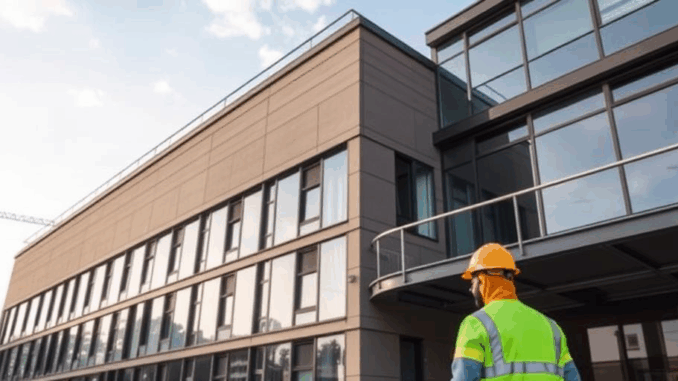
Summary
This article discusses the new building regulations in England requiring second staircases in residential buildings over 18 meters. This change, effective September 30, 2026, aims to improve fire safety. A transition period exists for projects approved before this date.
Focus360 Energy: property compliance services – pre-planning to post-construction. Learn more.
** Main Story**
So, England’s shaking things up when it comes to building regulations, and fire safety is, rightfully, at the heart of it all. You’ve probably heard about the new rule: second staircases are now a must for new tall residential buildings. Seems straightforward, right? But there’s more to it than meets the eye. As of September 30, 2026, any new residential building over 18 meters high needs that second staircase.
Why the extra stairs? It’s all about safety.
The Grenfell Tower tragedy, back in 2017, it’s something we can’t forget. It really highlighted how crucial fire safety is in high-rises. Following the incident and the Hackitt Review, the government was pushed to make some big changes. Experts, from the National Fire Chiefs Council to the Royal Institute of British Architects, were all for adding a second staircase. I mean, it makes sense, doesn’t it? It’s an extra way out if a fire breaks out, which dramatically improves the odds for the people inside. And if the “Stay Put” strategy, where people are told to stay in their apartments, isn’t viable, that second staircase becomes even more essential.
I remember a fire drill we had in my old office building. The main staircase was jammed, and everyone was scrambling for the fire escape. Made me realize how quickly things can go south.
Timelines and what it means for developers
Now, the government understands this is a big shift. If a project already got Building Regulations approval before September 30, 2026, it doesn’t need the second staircase. However there is a catch! Construction has to have really kicked off by March 30, 2028, or the whole thing could be a problem. It seems like the government is trying to give developers enough time to adjust without completely upending projects already in motion. The important thing to remember is, that according to the government, existing buildings with only one staircase aren’t necessarily unsafe, they just need to have been properly maintained, managed well, and comply with previous regulations. It’s all about meeting those requirements.
The Bigger Picture: Safety and Sustainability Together
This second staircase rule is just one piece of the puzzle. The Building Safety Act 2022, along with some other recent laws, are all about making sure safety is built into a building from the start, and remains a priority all the way through its life cycle. For taller buildings, over 18 meters, there’s a comprehensive plan in place, covering everything from who’s responsible to what records need to be kept. These changes are a sign that we’re, as a country, taking resident safety much more seriously, and aiming for safer buildings overall. What does this mean for the construction industry? Well, it means embracing these changes. It means putting fire safety first and using the best practices to keep residents safe. It’s a collective responsibility, and by working together, we can build a safer future. A future where these kind of regulations are second nature, and everyone feels that bit more secure in their homes and workplaces. It’s not just about ticking boxes; it’s about building a culture of safety and responsibility and lets be honest, a little bit of common sense too!


So, two staircases – does this mean twice the chance of accidentally ending up on the wrong floor? Asking for a friend who may or may not have a terrible sense of direction, but fully supports enhanced fire safety!
That’s a great point! I hadn’t considered the potential for increased navigational challenges. Perhaps developers will need to think about clearer signage or even colour-coding the stairwells. It’s a small price to pay for enhanced safety though, right?
Editor: FocusNews.Uk
Thank you to our Sponsor Focus 360 Energy
Two staircases! Does this mean double the opportunity for creative interior design in communal areas? Exciting times for landlords and tenants alike! Think of the possibilities with all that extra space!
That’s a fantastic point about creative design! The extra space from a second staircase definitely opens up possibilities for unique communal areas. Landlords could create inviting spaces that really enhance the living experience. What design ideas do you think would work well?
Editor: FocusNews.Uk
Thank you to our Sponsor Focus 360 Energy
A second staircase *and* a deadline? Developers must be stair-ing down the barrel of some serious project management! Anyone know if these new staircases need to be fire-resistant AND zombie-proof? Just planning ahead, you know.
That’s a great question! Fire-resistant materials are definitely a must, as per building regulations. Zombie-proof… well, that’s an interesting design consideration that might depend on your risk assessment! Always good to plan for all eventualities, though. What other far-future scenarios should building design consider?
Editor: FocusNews.Uk
Thank you to our Sponsor Focus 360 Energy